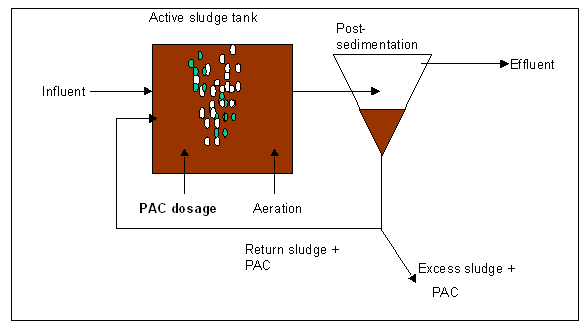Method diagram

Method and installation description
The aim of PAC dosage is to adsorb toxic substances or difficult to degrade material from wastewater, in order to allow the biological degradation process to take place without hinder, in changing influent compositions. The principle is based on adsorbing these components using activated carbon.
PAC production and dosage systems are needed for dosage into the aeration tank. Due to rising sludge quantities, it may also be necessary to install/configure a system for sludge treatment.
Specific advantages and disadvantages
It is difficult to control the process for adding powdered activated carbon to a biological system. The retention time of the added activated carbon is determined by the age of the sludge in the system.
Activated carbon dosage is possible in emergency interventions (e.g. if there is risk of a discharge norm being breached or in case of accident). It is very easy to (manually) dose activated carbon.
Attention must be given to avoiding dust problems (atomisation of powdered carbon into surrounding air). The actual appearance is a negative point (black aeration basins).
The presence of PAC also improves sludge sedimentation. Sludge production is increased proportionately with the addition of PAC. The presence of activated carbon could possibly influence the disposal possibilities for the excess sludge.
Application
Typical sectors where PACT is implemented include:
- Textile distribution (NACE 17.3); for purifying general wastewater or for the decolourisation of wastewater released in paint processes.
- The pharmaceutical industry (NACE 24.4), for end-of-pipe purification of wastewater that contains, among other things, metals and chlorinated hydrocarbons.
- Reducing the emission of AOX (e.g. treating cooling water in the chemicals industry).
Boundary conditions
Considering that activated carbon has abrasive properties, extra maintenance is generally needed for pipes and pumps. PE pipes are best suited for activated carbon slurries.
Attention must be paid to avoiding blockages in the dosage system.
Effectiveness
PAC dosage is primarily used for the removal of:
- Persistent organic compounds (pesticides and biocides);
- Organic compounds (e.g. AOX, BTEX (benzene, toluene, ethylbenzene and xylene), MAH, metyl tert-butyl ether and PAHs.
PAC dosage is expressed per litre of influent or per kg SS in the active sludge. Here are two dosage examples: 0.1-1.0 g PAC/l influent or 10 g PAC/kg SS and 0.05-0.2 g/l (supplier information). The optimum dose must be determined via experiments.
Support aids
Activated carbon is used as support aid.
Environmental issues
Active carbon and sludge are released as residual products.
Costs
The investment cost for an automatic dosage system with big-bags, amounts to approximately € 150.000. Manual dosage is also possible for smaller installations or emergency interventions, and requires no investment. The cost of powdered activated carbon is +/- 2 €/kg.
Comments
None
Complexity
No data available.
Level of automation
No data available.
References
- Environmental Technology, Monographs Handbook, Envi Tech Consult, INC, Den Haag, Handbook on Wastewater.
- VITO-SCT, revision of technical notes WASS, 2008
Version February 2010

